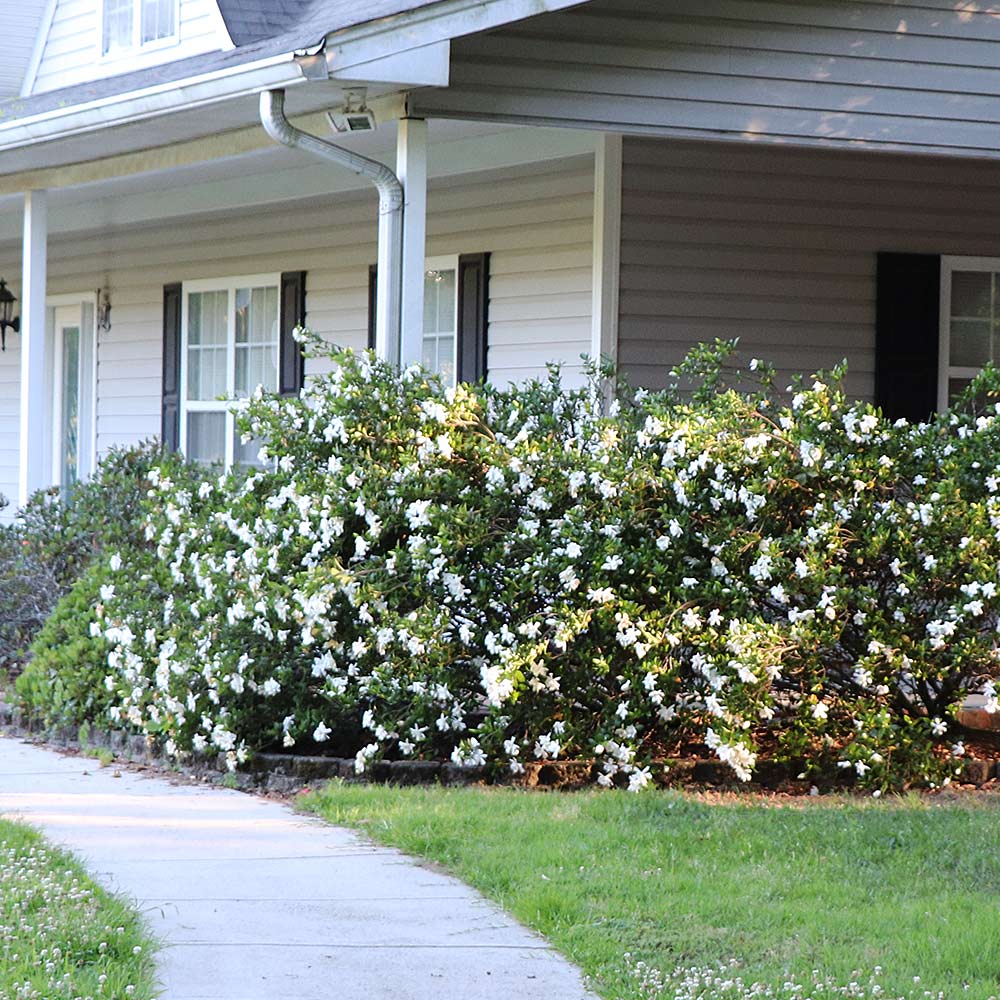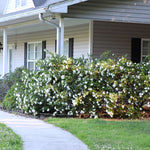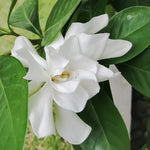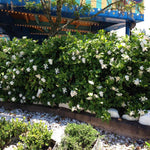Frost Proof Gardenia Shrub Gardenia jasminoides 'Frost Proof'

Frost Proof Gardenias create a wonderful shrub filled with fragrant blooms.



* Images shown are of mature plants
Frost Proof Gardenia Shrub Gardenia jasminoides 'Frost Proof'
Product Description
Blooms on the Bush... Not the Ground!
Finally... a fragrant gardenia plant that won't lose its flowers after late spring frosts.
Frost Proof Gardenias are famous for...
• keeping their blooms through unexpected freezes
• giant, fragrant blooms you can smell from a distance
• one tough plant that you don't have to baby
I love Gardenias, but refuse to spray chemicals or cover my plants.
Old gardenia plants are insect prone and finicky. Your soil can't be too moist or too dry. Then the occasional late frost comes and wipes out your blooms for the whole season.
New Frost Proof Gardenias are unaffected by cold snaps and thrive on neglect. They adapt to a variety of soil conditions... do great in full sun or partial shade... and resist insects and disease. Even deer leave them alone.
Warm, summer nights on Southern verandas would be lacking without the fragrance of gardenias wafting on the breeze. Gardenias are steeped in the South's botanical history; in fact, these plants were first cultivated in the U.S. in 1700s South Carolina. Although most gardenias are reliably hardy only to Zone 8, Frost Proof Gardenia pushes the hardiness envelope and makes it possible for gardeners outside the Deep South to grow this flowering gem.
• Compact evergreen shrub – keeps a tidy appearance; perfect for smaller gardens.
• Fragrant double flowers – exceptional form and fragrance from creamy-white blooms.
• Improved cold tolerance – withstands spring cold snaps without damage to flower buds.
When spring frosts burn the flower buds of other types of gardenias, the aptly-named Frost Proof Gardenia is specifically bred to hold up to freezing temperatures. This tough little shrub is not only classified as a cold-hardy gardenia, but it's also in a class called compact gardenias, which grow only 3 to 5 feet tall. But the primary reason to grow any gardenia is to enjoy its sweetly-scented blossoms. Unlike the single flowers produced on most gardenias, the Frost Proof Gardenia shrub is covered with velvety, creamy-white, double blooms in summer.
Appearance
Even when it's not in bloom, Frost Proof Gardenia is a beautiful evergreen shrub with glossy, dark-green foliage that stays pretty all year long. In stark contrast to the dark-green leaves, the 2- to 3-inch double flowers are resplendent in white. You'll see an abundance of blooms in early summer, but flowers continue to be produced sporadically throughout the growing season. Shrubs are slightly taller than wide '– typically up to 5 feet tall and 4 feet wide '– with a full and rounded form that fills in bare spots or gaps in your landscape.
Landscape Benefits
Fragrant Plant
Frost Proof Gardenia is one of the most fragrant plants you can grow. Sweetly scented, but not overpowering, a grouping of these plants will perfume your entire garden. And the fragrance from a single plant '– or a grouping of several '– will make your favorite sitting area even more enjoyable. This is definitely not a plant to be admired from a great distance -- you'll want to plant it where you'll get the maximum benefit from its intoxicating flowers.
Focal Point
As a single specimen plant, use Frost Proof Gardenia as a focal point in a mixed-planting of other perennials or annuals. You don't have to worry about its blooms competing with other flowers in the same bed, because the white blossoms of Frost Proof Gardenia provide a cool backdrop that blends with all colors.
Foundation Plant
A common landscape design mistake is planting foundation shrubs with mature heights that eventually cover first-floor windows, or which spread out and overtake other plants. You will love how Frost Proof Gardenia's size fits so nicely into your home's foundation design and how its growth stays restrained without becoming lanky or sprawling.
Woodland Garden
If you have a woodland garden that receives filtered or partial sun (not dense shade), Frost Proof Gardenia is a beautiful understory shrub to add. Dot it sporadically throughout the garden, line a path or cluster several plants around your sitting area in this garden.
Partial-Shade Garden
Frost Proof Gardenia needs some sun to look its best and produce flowers. But if you live in a hot climate with intense summer sun, you can include Frost Proof Gardenia in your partial-shade garden. "Shade" does not mean all-day shade for this plant. "Partial shade" means 4 to 6 hours of morning sun, followed by afternoon shade or filtered sunlight.
Low-Growing Hedge
Space a row of Frost Proof Gardenia shrubs 4 feet apart to create a stunning evergreen, flowering hedge. When the shrubs are in full bloom, each little gust of wind that blows across this hedge will infuse your entire yard with the exquisite scent of gardenia blossoms.
Living Fence
If your yard seems to blend in with the property on both sides, but you don't like the look of an unsightly wooden or chain-link fence, plant Frost Proof Gardenias as a living fence. You can space the plants as you would for a hedge '– 4 feet apart '– or you can space them more widely to add definition to your yard without growing a solid hedge. Your living fence will grow only 5 feet tall, so it won't overpower even a small yard.
Compact Green Screen
If you don't need an entire hedge or living fence in your yard, Frost Proof Gardenia shrubs also make the perfect small screen to hide an unsightly object or view. Simply space as many shrubs as needed to form the screen, planting them 4 feet apart, and at least 4 feet away from any structures. (If you're planting a green screen in front of an A/C unit, make sure to place plants so their mature size does not block the air flow.)
Container Plant
If you're tired of planting annuals in pots each year, only to have to re-plant the containers each year, consider potting perennials. If you've never thought about planting a shrub in a container, Frost Proof Gardenia is a super potted plant choice. These shrubs need good drainage, which containers offer; and because of its compact size, Frost Proof Gardenia nicely fills a large pot.
Cut Flowers
Your formal dining table will look even more elegant when dressed with fragrant Frost Proof Gardenia blossoms floating in shallow bowls of water. You can also cut entire stems of flowering gardenia for taller floral arrangements. One of gardenia's vintage uses was as a corsage flower. Although you may not have an occasion to wear a traditional corsage because of today's less-formal styles, you can always break with tradition and pin a fragrant gardenia blossom to a summer jacket as you step out to lunch or attend any social affair. Chances are, you'll have lots of admirers who comment on Frost Proof Gardenia's luxurious double blossoms as a unique accessory. Just wait until you tell them that you grew it in your own garden!
Tolerance
Late spring frosts- Just when you think the weather in spring has warmed enough that the threat of freezing weather has passed, a late frost kills the flower buds of many plants. When this happens, you have to wait for another year to roll around before you can enjoy the blooms. Frost Proof Gardenia earns its name by being able to withstand late-spring frosts so you don't miss flowers later that summer.
Heat- Frost Proof Gardenia sails through the heat of summer like a champ. In cooler regions of its hardiness zone, this plant can handle full sun, but in hotter climates, it prospers with 4 to 6 hours of morning sun and a little shade from the intense afternoon sun.
Humidity- Although some flowering plants, including other types of gardenias, don't hold up well in the humid climate of the Deep South, Frost Proof Gardenia is unflagging. This tough little shrub thrives in 50 to 60 percent relative humidity.
Deer Resistance
Frost Proof Gardenia is surprisingly resistant to deer. This is good news for gardeners who live in rural areas, because it's challenging to find flowering plants '– or even foliage plants '– that are not left tattered after hungry deer graze on them.
When to Plant
The best times of year to plant Frost Proof Gardenia are fall, winter and spring. In the cooler weather of these seasons, shrubs have an easier time acclimating to a new site as their root systems begin developing. Although you can also plant Frost Proof Gardenia shrubs in the summer, you must be diligent in watering them sufficiently so their roots don't dry out.
Where to Plant
Many landscape plants fail because they were simply planted in the wrong spot. Selecting a suitable site is critical to a gardenia's continued health.
Hardiness Range
Choosing plants that are hardy in the growing zone where you live is an important consideration for establishing a garden with plants that can survive winter temperatures. Frost Proof Gardenia grows as a perennial in USDA plant hardiness zones 7 through 11. It is marginally hardy in some areas of zone 6, which means it may grows as a perennial in protected garden spots or regions with warmer micro-climates.
Sun or Shade
In most gardens, the best spot to plant Frost Proof Gardenia is where it receives full sun in the morning '– 4 to 6 hours '– and filtered or partial sun in the afternoon. However, it also tolerates full sun in all but the harshest climates across its hardiness range.
Soil
Frost Proof Gardenia adapts to many types of soils, including sand, loam and clay. Regardless of the type of soil, the soil must drain well. If your garden spot contains heavy clay, you'll want to loosen the soil by adding organic amendments. As an option, you can plant Frost Proof Gardenia in a raised bed so the water drains more easily.
Mature Plant Size
This is a very important step in deciding where to plant your gardenia. Although the plants we ship to you are healthy and full, they are still actively growing and have not reached their mature size yet. Don't select a planting site based on the immature size of your Frost Proof Gardenia; instead, consider what it will look like when it's fully grown and plant accordingly so you don't crowd other plants or locate it too close to structures, such as fences or outside walls.
Before you Plant
Even before you remove new plants from their nursery pots, take the time to prepare their new "home" '– the planting site '– to give them the best leg up for healthy growth.
Soil pH
The pH of your soil is important for growing healthy Frost Proof Gardenias. These plants grow best in acidic soils, from 5.0 to 6.0. If you take a soil sample to your local Cooperative Extension Service, they'll test the soil pH and advise you what to add the soil if you need to adjust the pH. In soils that are too alkaline, gardenia leaves may turn yellow. If you plant Frost Proof gardenia shrubs as a border along a concrete sidewalk, driveway or patio, the gradual leaching of limestone in the cement may raise the soil pH outside gardenia's optimal acidic range. Just keep an eye on your plants and notice if some of the leaves begin to turn yellow so you can adjust the soil pH, if needed.
Amending the Soil
Soil amendments are not fertilizers, although some amendments do provide nutritional value. Amendments enrich and improve the soil structure, creating a healthier environment for plant roots to grow and develop. It's better to amend an entire growing site than to add amendments to individual planting holes. You can get your Frost Proof Gardenias off to a healthier start by spreading 2 inches of organic matter, such as compost, on top of the soil and incorporating it to a depth of 6 inches.
Underground Utilities
If you have underground utility lines, call a locate service company so they can mark the ground above any buried utility cables before you dig.
How to Plant
Planting Hole Depth and Width
It's essential to plant Frost Proof Gardenias at the proper depth. Dig planting holes no deeper than the root ball of each plant. You can even plant gardenia shrubs so they're slightly higher than the soil level to make sure they're not buried too deeply. If you didn't amend the entire planting site, dig planting holes three times the width of each root ball. After you place plants in the holes, backfill with the soil you removed, and very lightly firm the soil around each plant.
Mulching
Frost Proof Gardenias like moist, but not soggy, soil. By applying a 2- to 3-inch layer of mulch around each plant, such as pine straw, chopped leaves or shredded bark, this will help keep the soil moist. Frost Proof Gardenias also have fairly shallow root systems, so a layer of mulch helps protect their roots from damage. Pull the mulch away from the base of each plant; otherwise new roots may grow into the mulch instead of into the soil.
Watering
Water your newly-planted gardenias thoroughly so the entire root system is moistened. If natural rainfall doesn't provide 1 inch of water each week, hand-water your gardenias so their roots stay hydrated. Direct the water at the base of each plant instead of soaking the foliage.
Ongoing Care
Water
Continue to water your gardenias deeply once a week during any periods of drought or low rainfall, particularly in the heat of summer. Drip irrigation by soaker hoses or weep tapes provide an easy way to keep plants watered, especially if you install a timer for automatic irrigation.
Fertilizer
To determine if your soil has any nutrient deficiencies, take a soil sample to your local Cooperative Extension Service. They will perform a soil test and interpret the results, making recommendations for any needed fertilizer. Typically, you'll fertilize your Frost Proof Gardenias twice a year '– a light application after frost has passed in spring and another application 6 weeks later. This helps maximize the bloom potential of your plants. Look for fertilizers that are formulated for other acid-loving plants, such as azaleas and camellias and follow all label recommendations.
Pruning/Shaping
Frost Proof Gardenias don't need much '– if any '– pruning. If you want to shape your shrubs, prune them after their initial heavy blooming in summer. You can pinch out just the growing tips to make plants bushier, or you can cut plants back to reduce their height. Don't prune past late summer, which can reduce the number of next year's blooms.
Spraying/Pests
You may see whiteflies on your gardenias from time to time. They're easily controlled by spraying your plants with insecticidal soap, which comes premixed in an easy-to-use spray bottle at nurseries and garden stores.
History
Even though it's a Southern heritage plant, the gardenia's native habitat is China. In 1761, gardenias were first shipped to the U.S., where John Ellis grew them in South Carolina. Ellis honored his friend, Dr. Alexander Garden, a Charleston physician, by requesting that the genus "Gardenia" be named for him. The plants Ellis originally cultivated in South Carolina became the foundation plants for all the gardenias that were later grown in England. Their primary use was as a fragrant flower for corsages.
Trivia
As a member of the Rubiaceae plant family, gardenias are botanically related to the coffee plant.
Be sure to order large, 3 gallon Frost Proof Gardenias if they're available. You get older, well-developed plants that have already gone through several blooming seasons. This means you get more flowers- sooner! Don't wait years for blooms!
Shipping Details
Estimated Shipping Time: Most orders ship within 1-2 days. As noted on the website, some items are seasonal, and may only ship in spring or fall. Once your order is shipped, you'll receive an email with a tracking number.
| Order Total | Shipping Charges |
|---|---|
| Less than $100 | $24.95 |
| $100.00-$128.99 | $29.95 |
| $129 + | FREE SHIPPING! |
Product Details
Growing Zones: 7-10 outdoors
 7-10 outdoors
(hardy down to 10℉)
7-10 outdoors
(hardy down to 10℉)
- Mature Height: 3-4 ft.
- Mature Width: 3-6 ft.
- Sunlight: Full to Partial Sun
- Blooms: Spring - Summer
- Spacing: 3 ft.
- Growth Rate: Slow Growing
- Does Not Ship To: AZ
Customer Reviews & Photos





